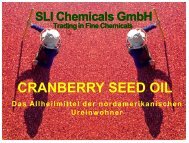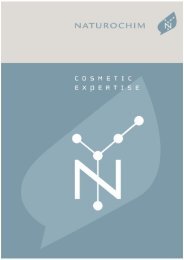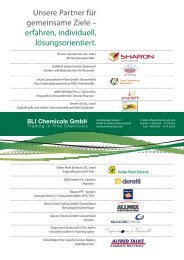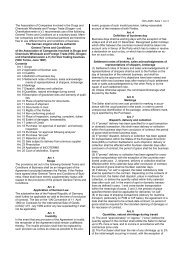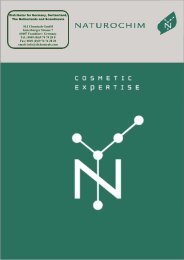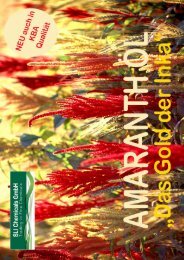Natur Products, Brochure - SLI Chemicals GmbH
Natur Products, Brochure - SLI Chemicals GmbH
Natur Products, Brochure - SLI Chemicals GmbH
Create successful ePaper yourself
Turn your PDF publications into a flip-book with our unique Google optimized e-Paper software.
DISCOVER OUR<br />
NATURAL RAW MATERIALS
Amaranth Oil<br />
The Gold of the Inca<br />
A naturally occurring raw material with effective ingredients<br />
(Squalene, Linoleic acid)<br />
The amaranth plant (which belongs to the amaranth family) is a tall, annual plant, which originally grew in South<br />
America. The amaranth plant is now found all over the world and is cultivated as a crop. Up to 150,000 grains<br />
form on the stems of each plant. Both oil and flour are extracted from these grains. Amaranth flour has already<br />
found a use in the food industry. It has a high protein content, the quality of which is better in comparison with<br />
the most varied types of cereals. The flour is also gluten free. This makes it suitable for people who have a<br />
gluten allergy (celiac disease) and for people with skin problems.<br />
The oil (only 5-6% of which is contained in the seeds) is extracted using CO 2 extraction, which protects the<br />
materials (no solvents). Amaranth oil has a remarkably high content of natural squalene. The table below<br />
presents a comparison of the amount of squalene in amaranth oil in comparison to other cosmetic oils:<br />
Approx. amount of squalene in %<br />
Amaranth Oil 5,0 – 8,0<br />
Olive Oil 0,4 - 0,8<br />
Corn Oil 0,03<br />
Peanut Oil 0,03<br />
Sunflower Oil 0,01<br />
Coconut Oil 0,002<br />
Ingredients of Amaranth Oil<br />
Amaranth oil is notable for its high squalene and linoleic acid content. The ingredients are given below:<br />
Characteristics of the product<br />
• Palmitic acid (C16:0) 15-25 %<br />
• Oleic acid (C18:1n9) 15-30 %<br />
• Linoleic acid (C18:2n6) 40-50 %<br />
• Stearic acid (C18:1) 2-5 %<br />
• Other fatty acids 3-6 %<br />
• Squalene 5-8 %<br />
• <strong>Natur</strong>al vitamins E 5-10 mg/100 g<br />
• Saturated fatty acids 20-24 %<br />
• Mono-unsaturated fatty acids approx. 20 %<br />
• Poly-unsaturated fatty acids approx. 50 %<br />
Amaranth oil supports skin regeneration and helps the skin's protective layer to be renewed. This is because of<br />
the composition of the oil and its high squalene content. It activates cellular protection, increases the skin’s<br />
ability to retain moisture and minimises transepidermale water loss. Amaranth oil soothes, regenerates and<br />
cares for the skin. It absorbs UV rays and protects against UV irritations and free radicals – the anti-aging effect.<br />
Amaranth oil is suitable for treatment of chronic skin dryness. It also has proven anti-inflammatory qualities. It<br />
smoothes and softens the skin, making it more elastic and relaxed. Wrinkles are decreased.<br />
Declaration:<br />
INCI NAME: AMARANTHUS CAUDATUS SEED EXTRACT<br />
CAS No.: 223747-79-3
Product Specification<br />
PRODUCT AMARANTH OIL<br />
PRODUCT<br />
DESCRIPTION<br />
<strong>Natur</strong>al Amaranth oil extracted by supercritical carbon dioxide from<br />
milled amaranth grain is high in squalene and unsaturated fatty acids.<br />
Amaranth oil is a natural product which contains natural<br />
alpha-Tocopherol (Vitamine E).<br />
INCI – NAME AMARANTHUS CAUDATUS SEED EXTRACT<br />
CAS No. 223747-79-3<br />
COLOUR Yellow – gold, clear liquid oil<br />
ODOUR Characteristic, slightly nutty<br />
SOLUBILITY Irresolvable in water, temperable and soluble in fats and organic<br />
resolvents for oil<br />
1. CHEMICAL AND PHYSICAL<br />
SPECIFICATION<br />
2. BACTERIOLOGICAL SPECIFICATION<br />
Saturated fatty acids app. 20-24 % Total viable count * max. 300/g<br />
Monounsaturated fatty<br />
acids<br />
Polyunsaturated fatty<br />
acids<br />
app. 20 % Coliforms * max. 50/g<br />
app. 50 % Mould * max. 100/g<br />
Palmitic acid (C16:0) 15 – 25 % Yeasts * max. 150/g<br />
Oleic acid (C18:1n9) 15 – 30 % 3. HEAVY METALS<br />
Linoleic acid (C18:2n6) 40 – 50 % Cadmium max. 1 ppm<br />
Stearic acid (C18:1) 2 – 5 % Mercury max. 1 ppm<br />
Other acids 3 – 6 % Arsenic max. 1 ppm<br />
Squalene 5 – 8 % Lead max. 1 ppm<br />
<strong>Natur</strong>al vitamin E 5 – 10 mg / 100 g Total content * max. 10 ppm<br />
Monoglyceride approx. 17 - 18 % 4. PARAMETERS<br />
Diglyceride approx. 20 % Melting point - 27°C<br />
Triglyceride approx. 50 % Density *<br />
Acid number * max. 40 mg KOH/g Viscosity<br />
Peroxide number * max. 10 mmol/Kg Saponification number<br />
0,90 – 0,94 g/cm 3 at<br />
20°C<br />
115 – 125 cSt at<br />
20°C<br />
170 +/- 35 mg<br />
KOH/g<br />
Iodine number * 100 - 140 Refraction index * 1,4710 – 1,4740<br />
* All starred points are part of the certificate of analysis. These values are tested each batch and the results are indicated in<br />
the certificate of analysis.<br />
RECOMMENDED STORAGE Original packaging, storage temperature 20 – 25°C<br />
PACKAGING Tinplate canisters ( 4,5 / 9 / 18 Kg ) Filled under argon atmosphere<br />
STORAGE STABILITY Under argon atmosphere stable 12 months after production. At room temperature<br />
clear yellow liquid (Cold stocking can cause a mild cloud of oil, which does not influence<br />
its quality – cloud be removed by warm up to 30 – 35°C, for the duration of<br />
diathermy for minimal 12 hours in original closed packaging while shaking)<br />
COMMENT: Light mild cloud incurred by excretion of wax like solids does not influence quality
Organic sea buckthorn pulp oil<br />
General information<br />
SANDDORN GbR Quality<br />
Product data sheet and specification<br />
The berries of the sea buckthorn (hippophae<br />
rhamnoides L.) are the most nutritious and<br />
unusual of the domestic fruits. They are to<br />
be found primarily in Central Asia and also<br />
everywhere in Europe, predominantly in<br />
coastal and mountainous regions. The pulp<br />
of the fruits grown under contract in<br />
Germany to certified organic standards<br />
contains up to 2 % oil on average, which is<br />
extracted in its virgin form, i.e. in the form<br />
in which it is found in the fruit, avoiding<br />
stressful influences (e.g. high mechanical<br />
stress, high temperatures, high pressure,<br />
drying out), using a pure mechanical<br />
separation procedure. It is orange-coloured<br />
and smells fruity. The fruit pulp is<br />
characterised by its high content of palmitic<br />
and palmitoleic acid, provitamin A (carotenoids, in particular beta carotene) and vitamins E and K. The oil usually<br />
already starts to crystallise out below 20°C and is usually of a firm consistency below 15°C. Due to the complex<br />
composition of the oil, discolorations can occur but these are completely reversible even when heated. This does<br />
not affect the dietary and physiological quality of the oil.<br />
Product information<br />
Sea buckthorn oil is free of additives.<br />
The product corresponds to the valid food law provisions of the Federal Republic of Germany and the European<br />
Union as well as the dietary regulations for infants and small children. It is not produced from genetically<br />
modified foodstuffs. Nor have any methods of genetic engineering been used in its production. Continuous<br />
control from the cultivation of the raw materials, via crop and after-crop preparation, to processing ensures a<br />
high quality of product, i.e. residual quantities of agrochemicals and traces of heavy metals are lower than those<br />
defined in the Regulations on Maximum Residue Limits (Rückstands-Höchstmengenverordnung (RHmV)). The<br />
products are virtually free of mycotoxins within the framework of conventional verification procedures.<br />
Use<br />
Sea buckthorn pulp oil has long been used in traditional medicine in Central and Eastern Asia.<br />
The cosmetics industry uses organic sea buckthorn pulp<br />
oil for emulsified and oily skin and hair preparations.<br />
It is particularly beneficial on dry, sun-reddened and<br />
stressed skin.<br />
The carotenoids trap free radicals, thus benefiting skin<br />
stressed by UV radiation and air pollution.<br />
The oil contains up to 70 % C-16 fatty acid compounds<br />
and thus types of triglycerides that do not occur in any<br />
other oil to such a high degree. These are mediumpolar,<br />
which influences the particular emulsification<br />
capacity and also improves the spreadability.
Product Specification<br />
1. Key fat chemical values<br />
Density (20°C) g/cm³ 0.900 – 0.920<br />
Refraction index (20°C) 1.466 -1.468<br />
Acid value max. 10 ¹<br />
Iodine value 60 - 70<br />
Sapofinication value 200 - 210<br />
Water % 0.1 – 0.3<br />
Unsaponifiable fractions (petrol ether<br />
method)<br />
% approx. 2<br />
Peroxide value max. 5<br />
1 The acid value indicated reflects not only the fatty acids but also organic acids that are no<br />
measure of fat spoilage. Depending on the quality of the raw materials, fractions of organic<br />
acids can be transferred into the fatty oil and are included in the determination of the acid<br />
value.<br />
2. Composition of fatty acids<br />
Fatty acid C-atoms: Double bonds Content in %<br />
Different fatty acids < C 16:0 approx. 0.5 %<br />
Palmitic acid C 16:0 28 to 43 %<br />
Palmitoleic acid C 16:1 min. 25 %<br />
Stearic acid C 18:0 max. 2 %<br />
Oleic acid C 18:1 18 to 30 %<br />
Linoleic acid C 18:2 1 to 6 %<br />
Linolenic acid C 18:3 approx. 2,5 %<br />
Different fatty acids ≥ C 20 max. 1 %<br />
Free of trans fatty acids as a result of heat damage.<br />
3. Sensory features<br />
Form Liquid above 15°C<br />
Colour Orange to red<br />
Smell Characteristic of the species, tangy body under particular circumstances, fruity<br />
Taste Characteristic of the species, tangy body under particular circumstances, fruity<br />
Tocopherol distribution: α: approx. 50 %,<br />
β: approx. 12 %,<br />
γ: approx. 8 %,<br />
δ: traces<br />
4. Food value information<br />
Calorific value: 898,2 kcal/100 g<br />
Protein: < 0,1 g/100 g<br />
Carbohydrates: < 0,1 g/100 g<br />
Fat: 99,8 g/100 g<br />
5. Registrations<br />
CAS No.: 225234-03-7<br />
INCI NAME: Hippophae rhamnoides fruit oil<br />
CTFA: Seabuckthorn (Hippophae rhamnoides)<br />
6. Storage<br />
In tightly sealed containers, protected from light and not above room temperature (addition of<br />
nitrogen an advantage); oil in canisters and drums are covered from the producer with nitrogen directly<br />
May 2012
GENERAL INFORMATION<br />
Enhance the Activity of<br />
Your Cosmetics the<br />
NATURAL and EASY Way!<br />
CORN PO4 PH"B"<br />
CORN PO4 PH”B” is a multifunctional<br />
modified starch derived from corn certified<br />
as natural cosmetic ingredients by BDIH. It<br />
is a white, ultra fine powder manufactured<br />
by the cross-linking of corn starch. The<br />
product is highly purified to remove any<br />
impurities normally present in native<br />
starch. The particles have a remarkably<br />
large internal surface area. CORN PO4<br />
PH”B” is both highly hydrophilic and lipophilic.<br />
The starch particles efficiently adsorb<br />
substances dissolved in the water phase<br />
and due to the high over-drying, the<br />
sorption power is superior. At the same<br />
time, the particles do not become sticky or<br />
pasty in the presence of water or oil. CORN PO4 PH”B” is not soluble in any solvent and is compatible with all<br />
cosmetic raw materials (active ingredients, deodorizing agents, preservatives etc.). It can be utilized in many<br />
types of formulations (from powders to lotions and creams).<br />
COSMETIC ACTIVITY<br />
• Enhanced efficacy of active ingredients<br />
- when added to the water phase, CORN PO4 PH”B” first adsorbs the water along with any water<br />
soluble actives. During the emulsification process, the starch particles absorb some amount of the<br />
oils phase with the oil-soluble actives. When this emulsion is applied to the skin, the emulsion<br />
breaks and water evaporates, but the active ingredients entrapped in the CORN PO4 PH”B” are<br />
gradually released to the skin over a prolonged period.<br />
• Long-lasting moisturizing effect<br />
- CORN PO4 PH”B” ‘locks in’ moisture adsorbed from the water phase of your formulation. When<br />
applied, this water is released over a long period, providing moisture to the skin throughout the<br />
day.<br />
• Antimicrobial effect<br />
- when CORN PO4 PH”B” is applied to the skin as a powder, it adsorbs the surface moisture, creating<br />
a hostile environment for bacteria without disturbing the skin.<br />
• Improved spreadability of emulsions<br />
- even in the presence of high levels of petrolatum.<br />
• Long-lasting, pleasant and silky skin feel<br />
- CORN PO4 PH”B” reduces the greasiness and stickiness of emulsions containing lipophilic<br />
ingredients (vegetable oils and butters, petrolatum, paraffin oils, waxes).<br />
• Mattifying effect<br />
- in emulsions - CORN PO4 PH”B” reduces the shininess on the skin caused by different lipophilic<br />
ingredients present in emulsions (vegetable oils and butters, petrolatum, paraffin oils, waxes).<br />
- on skin - CORN PO4 PH”B” adsorbs sebum resulting in an immediate mattifying effect with longlasting<br />
results.<br />
• <strong>Natur</strong>al antiperspirant agent<br />
- CORN PO4 PH”B” adsorbs perspiration released by the skin.<br />
• Supports the effect of self-tanning products<br />
- products containing CORN PO4 PH”B” spread easily on the skin, resulting in a more uniform,<br />
natural-looking tan.
Product Specification<br />
General Description<br />
• INCI NAME: DISTARCH PHOSPHATE<br />
• CAS No: 55963-33-2<br />
• EINECS No.: 232-679-6<br />
• Chemical characteristic:<br />
Di-starch phosphate ester<br />
on base of corn starch<br />
CORN P04 PH “B“<br />
sterilizable maize starch<br />
ANALYSIS DATA METHOD<br />
pH-value: 5,5 – 7,0 10 % slurry<br />
Sedimentation (mL): 45 – 75 mL 10 % cooked slurry, graduated<br />
cylinder<br />
Chloride (in dry<br />
substance):<br />
max. 1500 ppm Titration<br />
Sulphate (in dry<br />
substance):<br />
max. 2000 ppm Titration<br />
Total ash: max. 1,5 % 650°C<br />
Moisture: max. 6,0 % ISO 1666<br />
Heavy metals: max. 10 ppm AAS<br />
MICROBIOLOGY<br />
Total plate count: max. 100/g ISO/Pharm. Eur.<br />
Yeasts: max. 10/g ISO/Pharm. Eur.<br />
Moulds: max. 10/g ISO/Pharm. Eur.<br />
E. Coli: negative/g ISO/Pharm. Eur.<br />
Staphylococcus aureus: negative/10g ISO/Pharm. Eur.<br />
Pseudomonas aeruginosa: negative/10g ISO/Pharm. Eur.<br />
Enterobacteriaceen: negative/g ISO/Pharm. Eur.<br />
Salmonella: negative/10g ISO/Pharm. Eur.
ROYAL JELLY, LYOPHILISED<br />
Also available as “Native” material<br />
Royal Jelly:<br />
a viscous, white-yellow substance mixture<br />
produced by the bee in a special gland.<br />
Amongst other substances it contains<br />
carbohydrates, fatty acids, proteins, free<br />
amino acids, numerous vitamins, mineral<br />
elements, and trace elements. The free<br />
fatty acid 10-HDA (10-hydroxydecenoic<br />
acid) is especially important, as it is rarely<br />
to be found in nature but is highly<br />
concentrated in Royal Jelly. Royal Jelly is<br />
also known as "Royal Juice", since it is the<br />
queen bee's only source of nutrition. It is<br />
effective in helping the queen bee to<br />
develop faster, making her extraordinarily<br />
fertile (up to 2000 eggs are laid daily) and granting her a life span of up to six years. In contrast other<br />
bees, which receive Royal Jelly only in their first three days of life, live only up to six months.<br />
Description<br />
Quality: Pharma - Food - Cosmetic<br />
Appearance: Powder<br />
Average Grain Size: < 100 µ<br />
Colour: White to light yellow<br />
Odour: Typical<br />
Taste: Typical<br />
Loose weight: 530 - 590 g/L<br />
INCI NAME: ROYAL JELLY POWDER<br />
CAS-No.: 8031-67-2<br />
EINECS/ELINGS-No.: 310-127-6<br />
Storing: Dry, dark and cool<br />
Shelf life: At least 3 years at room temperature<br />
Specifications (Average values)<br />
Water and Volatiles: 6,0 %<br />
Ashes: 3,5 %<br />
pH-value: 4,4<br />
Fat (at Weibull-Stoldt): < 1 %<br />
Protein: 40,0 %<br />
Glucose: 14,0 %<br />
Fructose: 14,0 %<br />
Saccharose: 5,0 %<br />
10-Hydroxy-2-decen acid: 4,5 %<br />
Analysis<br />
Identity: Sensory Examination<br />
Ingredients: According to above specifications<br />
Microbiological<br />
Examination:<br />
Ph.Eur. 2005, Category 3B, FIP<br />
Aflatoxine: § 35 LMBG/ Mykotoxin–Höchstmengenverordnung MHmV (German Food Law)<br />
Pesticides: Ph.Eur. 2005/Rückstands-Höchstmengenverordnung RHmV<br />
Heavy Metals: German recommendation for pharmaceutical products (BMG 17.10.91)<br />
Antibiotics: Chloramphenicol, Nitrofuran, Sulphonamides, Trimethoprim, Tetracycline,<br />
Streptomycin<br />
Each lot will be analyzed through an independent and sworn German chemist. Concerning the pollution, the<br />
product meets with the regulations according to Ph.EUR. 2005 (European Pharmacopoeia) and can be used for<br />
pharmaceutical and cosmetic products as well as for food preparations.
PROPOLIS TINCTURE 20 %<br />
Propolis: a somewhat glutinous and sticky thermoplastic substance mixture which worker bees<br />
collect from tree bark and buds which contain resin; also known as putty resin or bee glue. Propolis,<br />
which contains flavonoids, organic acids, free amino acids, numerous vitamins and trace elements,<br />
works as a highly effective natural antibiotic in the beehive which protects the bees from viral,<br />
bacterial and mould infections. At the same time it functions as a building material for sealing the<br />
beehive. (See also The Discovery of Propolis by K. Lund Aargard).<br />
Description<br />
Quality: Pharma - Cosmetics<br />
Appearance: Liquid<br />
Colour: Dark brown - red brown<br />
Taste: Hot and spicy<br />
Odour: Alcoholic, typical<br />
Solvent: 96 % (V/V) Ethanol, undenatured<br />
INCI NAME: PROPOLIS EXTRACT<br />
CAS-No.: 85665-41-4 (Propolis), 64-17-5 (Ethanol)<br />
EC-No.: 288-130-6 (Propolis), 200-578-6 (Ethanol)<br />
Storing: Airproof, dry, cool and dark<br />
Shelf life: At least 3 years at room temperature<br />
Specification<br />
Identity: DC-Fingerprint<br />
Dry substance: > 18 % (m/m)<br />
Relative density: 0,860 – 0,896<br />
Ethanol content: > 72,0 % (V/V)<br />
Ashes: < 0,2 % (m/m)<br />
Total Flavonoids in<br />
dry substance :<br />
Analysis<br />
> 5 % (m/m)<br />
Identity Flavonoids: DC-Fingerprint<br />
Pesticides: Ph. Eur. 6, 2008<br />
Aflatoxine: § 64 LFBG / Mykotoxin-Höchstmengenverordnung MHmV / Regulation<br />
1881/2006/EC<br />
Monography: according to specification<br />
Microbiological Status: Ph. Eur. 6, 2008<br />
Heavy Metals: German recommendation for heavy metals in vegetable<br />
pharmaceutical products (BMG 17.10.91)<br />
Each lot will be analyzed through an independent and sworn German chemist. Concerning the<br />
pollution, the product meets with the regulations for herbal drugs according to the European<br />
Pharmacopoeia (Ph.Eur. 6, 2008) and can be used for pharmaceutical and cosmetic products.
ALOE VERA FREEZE DRIED<br />
POWDER 200:1ORGANIC / CONVENTIONAL<br />
Also available as Gel 1:1, 2:1 and 10:1<br />
Description<br />
Aloe Vera Freeze Dried<br />
Powder 200:1 is obtained<br />
by a purification process of<br />
the inner gel (fillet) of<br />
freshly harvested leaves of<br />
the Aloe Vera Barbadensis<br />
Miller maintaining all the<br />
active ingredients. The gel<br />
is then further concentrated<br />
utilizing low temperature<br />
evaporation to produce a<br />
liquid concentrate ready for<br />
freeze drying. This product<br />
is manufactured without the<br />
use of a matrix, preservatives<br />
or other additives. When reconstituted, one part of this product with 199 parts of<br />
deionized water makes 200 parts of Aloe Vera Gel and contains all the active ingredients<br />
of the Aloe Vera Gel. Using this concentrated product considerably reduces shipping,<br />
storage and handling costs without sacrificing product activity.<br />
Application<br />
These products are recommended for Cosmetic, Food and O.T.C. Pharmaceutical formulations:<br />
Cosmetic & hair care Food O.T.C. pharmaceutical<br />
Creams Nutritional Healing Creams<br />
Shampoos / Conditioners Fruit Juices Sun Tan Lotions<br />
Hair Lotions Dietetic Ointments<br />
After-Shave Lotions Sports Drinks Anti Acne Preparations<br />
Facial Masks Fitness Drinks Tooth Pastes<br />
Make-Ups<br />
Lipsticks<br />
Hydrocortisone Creams<br />
Soaps<br />
Skin Conditioners<br />
Deodorants<br />
Styling / Sculpting Gels<br />
Oral Rinses
Caution<br />
No preservatives were added to<br />
this product during its<br />
manufacturing process and may<br />
darken with time if preservatives<br />
are not added when the product<br />
has been reconstituted.<br />
Recommendations<br />
It is recommended, in formulations,<br />
to use 20 % or more of single<br />
strength equivalent (100 %<br />
Aloe Vera Gel) in order to fully<br />
benefit from the Aloe Vera Barbadensis<br />
Miller’s rich and natural<br />
healing properties.<br />
Product specification<br />
CAS No.:<br />
85507-69-3<br />
INCI NAME:<br />
ALOE BARBADENSIS LEAF JUICE<br />
POWDER<br />
SPECIFICATION<br />
ALOE VERA FREEZE DRIED POWDER 200:1/ORGANIC<br />
Item Specification<br />
Appearance: Cream to light tan fine powder<br />
Moisture content: < 10.0 %<br />
After reconstitution pH: 3.5 – 5.0<br />
Specific gravity at 25°C: 0.997 to 1.004<br />
Dispersion rate at 25°C: < 5 minutes<br />
Microbiological at 48 hrs:<br />
Aerobic plate count: < 100 cfu/g<br />
Pathogenic count: Negative
GENERALL INFORMATION<br />
JOJOBA GOLDEN OIL<br />
Native Americans were<br />
using the oil for many<br />
purposes: for treating<br />
sores, cuts, bruises, and<br />
burns; as a skin<br />
conditioner, for soothing<br />
windburns and sunburns; as<br />
a hair and scalp treatment<br />
and hair restorative. The<br />
chemical structure of Jojoba<br />
oil is different from that of<br />
other vegetable oils. Rather<br />
than being an oil, it is<br />
actually is a polyunsaturated<br />
liquid wax that is similar to sperm whale oil, though without the fishy odor. It is<br />
made of fatty acids as well as esters composed entirely of straight chain alcohols. Both the<br />
acid and alcohol portions of Jojoba oil have 20 or 22 carbon atoms, and each has one<br />
unsaturated bond. Waxes of this type are difficult to synthesize. As a wax, Jojoba oil is<br />
specially useful for applications that require moisture control, protection, and emolliency.<br />
Jojoba oil is liquid at room temperature because of its unsaturated fatty acids. It does not<br />
oxidize or become rancid and does not break down under high temperatures and<br />
pressures. Jojoba oil can be heated to 370°F (188°C) for 96 hours without exhibiting<br />
degradation in general composition or carbon chain length. The stability shown by jojoba<br />
oil makes it especially useful for cosmetic applications.<br />
GENERAL USES<br />
Jojoba oil has many uses in a wide variety of industries. As a cosmetic, it is an effective<br />
cleanser, conditioner, moisturizer, and softener for skin and hair. It is applied directly to<br />
the skin to soften the skin, to reduce wrinkles and stretch marks, to lighten and help to<br />
heal scars, and to promote healthy scalp and hair. Jojoba oil does not plug the skin pores.<br />
Jojoba oil is similar to, and miscible with sebum, which is secreted by human sebaceous<br />
glands to lubricate and protect skin and hair. When sebum protection decreases due to<br />
age, pollutants, or environmental stresses, Jojoba oil can be used to replicate sebum oil.<br />
Jojoba oil can accumulate around hair roots, thereby conditioning hair and preventing it<br />
from becoming brittle and dull. If there is too much sebum build up on the scalp, it<br />
dissolves and removes the sebum, leaving the hair clean. Jojoba oil as a solubilizing agent<br />
can also remove sticky build up on hair from hair preparations as well as airborne<br />
particulates deposited on the hair. It forms a lipid layer on the skin, acting as a<br />
moisturizer, as well as penetrating and being absorbed by the outer skin layer. It is widely<br />
used as an ingredient in shampoos, conditioners, facial, hand and body lotions, cuticle and<br />
nail care products, baby care lotions, creams, and oils, cleansers, moisturizers, bath oils<br />
and soaps, sunscreen lotions and makeup products. Jojoba oil is also used in the<br />
manufacture of perfume. The potential therapeutic uses of Jojoba oil include the treatment<br />
of acne, cold sores, and such skin diseases as psoriasis.
SPECIFICATION<br />
Jojoba Golden Oil<br />
INCI NAME: Simmondsia Chinensis Seed Oil<br />
Commercial Name: Jojoba Golden Oil (R)<br />
CAS No.: 90045-98-0<br />
EINECS/ELINCS-No.: 289-964-3<br />
Description: Virgin oil obtained from Jojoba seeds, with no additives<br />
Extraction Method: Produced by cold press of ripe seeds<br />
Appearance: yellow clear oil; very light odour (faint characteristic)<br />
FATTY ACID COMPOSITION<br />
ITEM SPECIFICATION<br />
C16:0 Palmitic acid: 3.0 % max.<br />
C16:1 Palmitoleic acid: 1.0 % max.<br />
C18:1 Oleic acid: 5.0 – 12.0 %<br />
C20:1 Gadoleic acid: 65.0 – 80.0 %<br />
C22:0 Behenic acid: 1.0 % max.<br />
C22:1 Erucuc acid: 10.0 – 20.0 %<br />
C24:1 Nervonic acid: 3.0 % max.<br />
Others fatty acid: 3.0 % max.<br />
The Jojoba oil is also available as colourless and organic material.<br />
CHEMICAL AND PHYSICAL PROPERTIES<br />
ITEM SPECIFICATION<br />
Specific gravity (25°C): 0.863 – 0.873<br />
Moisture and insoluble impurities: 0.1 % max.<br />
Acid value: 1.0 max.<br />
Peroxide Values: 2.0 max<br />
Saponification value: 85.0 – 98.0<br />
Unsaponifiable matter: 45.0 – 55.0<br />
Iodine value: 80.0 – 92.0<br />
Colour gardner: 8.0 max.<br />
Refrective index: 1.465 – 1.467<br />
Microbiological total contamination, CFU: 10/1 g max.<br />
Pesticides residues: none
DESCRIPTION<br />
MELSCREEN COFFEE ORG<br />
Organically Certified Green Coffee Oil<br />
Organic coffee oil<br />
extracted from “Coffea<br />
Arabica” green coffee<br />
beans, specially<br />
obtained through a very<br />
careful cold pressing<br />
technique.<br />
INCI NAME:<br />
COFFEA ARABICA (COFFEE) SEED OIL + TOCOPHEROL<br />
CAS No.: 8001-67-0 + 2074-53-5<br />
BENEFITS<br />
It contains a very convenient percentage of linoleic acid (omega 6), which is an essential fatty acid. It is an<br />
essential skin lubricant which works as a true skin treatment<br />
It helps to restore the lipids present in the stratum corneum by restructuring those protective lipids and giving<br />
the skin a healthier appearances since it promotes skin hydratcon<br />
It restores the skin barrier. It helps to maintain the normal functions of the hydrolipidic barrier, its integrity, and<br />
results in a normal skin balance. It also helps to restore the keratinization process<br />
It has a capacity to decrease the skin damage from UV radiation, particulary UVB that causes erythema,<br />
because of the unsaponifiable matter range of approximately 11 %<br />
It presents approx. 75 % triacyglycerols (4ß % in linoleic acid, an essential fatty acid) and 14 % diterpene esters<br />
Due to the trpene esters is can have the following properties<br />
− Essential fibers production<br />
− Firming effects<br />
− Regeneration<br />
ADVANTAGES<br />
Rich in Omega 6 and unsaponifiable material<br />
Efficacy test – Clinical SPF test was performed and MELSCREEN COFFEE ORG reduced the erythema measured<br />
through the SPF boosting effect (about 25 %)<br />
SUGGESTED CONCENTRATION<br />
From 1,0 % to 5,0 % (w/w)<br />
APPLICATIONS<br />
MELSCREEN COFFEE ORG can be used in cosmetics formulations, mainly tanning and sunscreen lotions intended to:<br />
Lubricate the skin and regenerate the hydrolipid barrier that is constantly subject to aggressions, mainly from the<br />
sun;<br />
Photo-protect the skin against UV radiation, particulary UVB that causes erythema due to its high content of<br />
unsaponifiable matter. SPF Boosting effect in vivo tested;<br />
Skin care products, anti-aging products;<br />
Sun care products, including children’s products.
16<br />
14<br />
12<br />
10<br />
8<br />
6<br />
4<br />
2<br />
0<br />
PRODUCT SPECIFICATION<br />
Chemical Description: Organic Green coffee (Coffea Arabica) seed oil.<br />
Shelf Life: 24 months<br />
Country of Origin: Brazil<br />
Manufacturer: CHEMYUNION QUÍMICA LTDA.<br />
Quality Requirements:<br />
ITEM ANALYSIS METHOD UNITY SPECIFICATION<br />
5.1 Appearance (25°C) Visual - Limpid to slightly turbid, oily<br />
liquid<br />
5.2 Colour Visual - Greenish yellow to amber<br />
5.3 Odour Organoleptic - Characteristic<br />
5.4 Acid Value MA 002 CH mg KOH/g 10.00 Max.<br />
5.5 Saponification Value MA 003 CH mg KOH/g 140.00 – 190.00<br />
5.6 Peroxide Value MA 021 CH mEq/kg 12.00 Max.<br />
Pre-Inspections: 5.1; 5.2; 5.3; 5.4; 5.6.<br />
Bibliographical References: Not Applicable<br />
EFFICACY TESTS<br />
Clinical assessment of the sun protection factor of a sunscreen product with addition of<br />
5 % of MELSCREEN COFFEE ORG, according to the “Sun Protection Measurement<br />
Protocol”, issued by the COLIPA in 1994.<br />
SPF Placebo SPF Placebo<br />
5 % MELSCREEN COFFEE ORG<br />
SPF<br />
Result: The results are documented as SPF increase of approximately 25 % as shown in the<br />
graph above. MELSCREEN COFFEE ORG reduced the erythema caused by solar radiation
<strong>SLI</strong> <strong>Chemicals</strong> <strong>GmbH</strong> General Manager<br />
Stefan Stupp<br />
Insterburger Strasse 7<br />
D-60487 Frankfurt am Main Commercial Registry No.: HRB 55701<br />
Germany Tax-No.: 047 243 47854<br />
VAT-No.: DE813558901<br />
E-Mail: info@slichemicals.com<br />
Phone: +49 (0) 69 - 7474 28 0 Visit us online<br />
Fax: +49 (0) 69 7474 28 20 www.slichemicals.com



